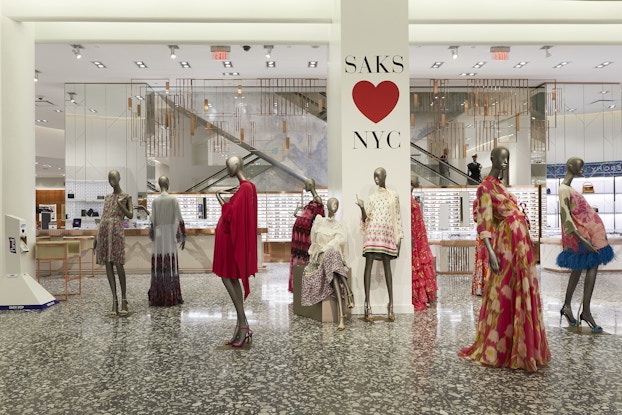
Key takeaways:
- The pandemic taught Saks that customers want luxury fashion even during a crisis.
- The department store chain’s fashion stylists generated $150 million in revenue during the pandemic, working with customers using new technology, like online chats with customers.
- Now that every retailer has data, personalization must mean more than knowing your customer’s name or birthday.
For a 153-year-old retailer, Saks Fifth Avenue proved to be quite nimble when the pandemic closed its stores. It added virtual appointments with its fashion stylists, embraced curbside pickup and improved its online experience.
But the most important lesson Saks learned from the crisis, according to president and CEO Marc Metrick, was that even in a pandemic, people crave fashion.
“We are a fashion company. That’s what Saks is. That has to be our truth,” Metrick said at the National Retail Federation’s virtual conference and trade show, attended by CO—.
Saks got a welcome surprise during the pandemic, he said. Its customers were still buying fashion; in fact, they seemed to crave it even more.
“Why else would you buy a 110-millimeter pump or high heel from a luxury brand when you’re working from home on Zoom all day?” Metrick asked.
The pandemic, he said, became “proof of concept” for the strategy he has been using to guide Saks: “that fashion is going to prevail.”
Finding ways to thrive in ‘the next normal’
Retail experts interviewed by CO— said Saks is well-positioned to thrive in what Metrick calls the “next normal,” but they noted that the department store will have to translate the high-touch experience of its stores for an increasingly digital world.
“The next challenge for retail is how do you present some emotion on the website,” Candace Cortlett, president of consulting firm WSL Strategic Retail, told CO—. “How, when people open the site, do they have that feeling of ‘Oh gee, it’s good to be here,’ that they got when walking into a Saks store.”
“I don’t necessarily want to open the Saks Fifth Avenue site and see ‘designer sale, 70% off,’” Corlett said. “I want to see the designers. I’ll find the 70% off, believe me. But I want to see Saks.”
Why else would you buy a 110-millimeter pump or high heel from a luxury brand when you’re working from home on Zoom all day?
Marc Metrick, president and CEO of Saks Fifth Avenue
“Luxury brands can no longer afford to simply offer their customers a digital catalog,” Hadar Paz, CEO and co-founder of Powerfront, told CO—. Powerfront is a customer-service solutions platform that works with luxury brands such as Gucci, Valentino and Saint Laurent.
Those brands “must invest in technologies that allow them to offer face-to-face service—be it via video chat, virtual try-on opportunities, live shows or even a live shopping experience that allows users to walk through a store virtually,” Paz said.
Metrick spent the first 15 years of his retail career at Saks, rising to chief strategy officer, before moving to Hudson Bay Company, where he played a key role in its acquisition of Saks. He became president of Saks in 2015 and was named president and CEO in 2020.
Hudson Bay reportedly has been exploring spinning off Saks.com from its physical stores,but in his talk, Metrick stressed the importance of making the online and in-store experiences mesh seamlessly.
'Luxury disrupted’
Saks began implementing a digital makeover strategy called “luxury disrupted” more than a year before the pandemic started.
That strategy has three pillars, Metrick said: fashion first; ease, or making the experience frictionless; and personalization.
The pandemic, he said, was “an accelerant to what was already happening. The consumer was already moving in this direction.”
Personalization—making a customer feel like a friend, remembering birthdays and anniversaries and knowing exactly what a customer likes—used to be what set luxury retail apart, Metrick said.
“Luxury owned that high-touch relationship,” he said. “Then, over time, data became the greatest equalizer, and almost everyone was able to personalize things more.”
To counter that shift, Saks is building technology to connect in-store experiences with online experiences, he said.

Saks launched a revamped website in October with in-store pickup and same-day delivery options, a “complete the look” feature with stylist recommendations and options for online chats with stylists.
Through the peak of the pandemic and even with stores closed, stylists were able to generate nearly $150 million in revenue online, Metrick said.
In addition to technology upgrades on the back-end, Saks needs to work on making its online experience more immersive and personal, offering platforms that can give online shoppers the kind of “red carpet” greeting and treatment they receive in a store, Paz told CO—.
“A warm, proactive greeting can go a long way to make a customer feel like they’ve just stepped into a store,” he said.
Metrick says his goal is to help Saks be more Saks-like and lean into its brand DNA, while adapting to new technologies and consumer behavior. “I want somebody to use Saks as an example of something great, something unique.”
The companies that win in the long run, he said, are the ones who understand their identity and stay true to who they are. “That’s what we’re doing at Saks.”
CO— aims to bring you inspiration from leading respected experts. However, before making any business decision, you should consult a professional who can advise you based on your individual situation.
Follow us on Instagram for more expert tips & business owners’ stories.
CO—is committed to helping you start, run and grow your small business. Learn more about the benefits of small business membership in the U.S. Chamber of Commerce, here.
CO— Exclusives: Insider Strategies
How the buzziest brands and hottest startups are solving today's biggest business challenges. CO— brings you advice from startup founders and top executives for thriving in a new world.








